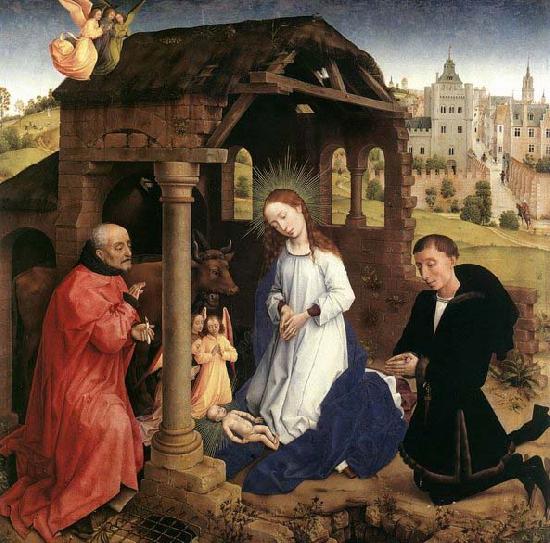New Crafts International LLC Europe
WEYDEN, Rogier van der
Bladelin Triptych
Gemälde IDENTIFIZIERUNG: 63918
1445-50 Oil on oak panel, 91 x 89 cm Staatliche Museen, Berlin The centre of the triptych shows the Nativity of Christ. The donor wore clothes of a similar fashion to those occurring in Rogier's miniature in the Hainault Chronicle. Apart from the fact that the donor's coat is not made of costly brocade, it greatly resembles the one worn by the duke in the miniature. Unlike Philip, who as the highest-ranking person present keeps on his hat, the "chaperon," the donor in the triptych, kneeling before the Christ Child, has removed his, and wears it slung behind him on his back. The donor of the Middleburg Altarpiece is more closely integrated with the scene than in almost any other Early Netherlandish painting. In his position and attitude he takes the place, within the Nativity narrative, of a shepherd praying, a motif frequent in pictorial tradition. Even in Rogier's Crucifixion Triptych (Kunsthistorisches Museum, Vienna), the married couple who commissioned the work are much more obviously outside the events shown, because their attitude of prayer cannot be seen as part of the narrative. But the donor of the Middelburg Altarpiece too is present only in spirit, witnessing the incarnation of God in his meditations. In order to put sufficient distance between him and the Virgin, the artist has resorted to a device already found in the Deposition (Prado, Madrid): the contours of his figure come very close to other items in the pictorial area, but overlap them to a minimal extent. The donor's head comes short of the ruined wall confining the area containing the Virgin, his hands are close to the outline of her dress but do not quite touch it, and the outline of his coat runs past Mary's robe with only a very slight overlap. The man is kept within a vertical area of the painting (an effect reinforced by the black he wears), an area also containing the fine town with its worldly bustle that is his real environment, although here, of course, it represents Bethlehem. The gap in the little wall behind the donor on the right denotes the road he has taken away from everyday life in his piety, an idea also suggested by the end of his head-dress lying on the ground. A carefully calculated equilibrium is perceptible in the composition. There are three large figures on each panel - even the left-hand panel, where the emperor's two advisers at the back are in fact almost hidden by the one in front. The group around the Christ Child describes an upward-pointing triangle, balanced by a downward-pointing triangle created by the outline of the diagonally placed ruin and the two holes in the foreground, which are set on a slant. This surface pattern in the shape of a horizontal rhomboid, however, also creates depth, since the corner of the ruin projecting forward and the figures graduated in a sequence moving backward interlock spatially. But as usual, Rogier restricts the back part of the stage on which his main figures are set: the back wall of the ruin, the wall of Octavian's apartment, and the hill behind the Magi all act as visual barriers at about the same depth. The main purpose of the triangular composition, however, is to emphasize the Virgin Mary, particularly since she is placed approximately on the central axis of the picture. This position might seem natural, but is in fact unusual in depictions of the Nativity, where Mary is generally placed to one side, next to the Child. The dark wall also acts as a contrasting background and forms a kind of baldachin over Mary. This manner of depicting the Virgin was another of Rogier's successful ideas, imitated by many other artists.Artist:WEYDEN, Rogier van der Title: Bladelin Triptych (central panel) Painted in 1401-1450 , Flemish - - painting : religious

Siehe Galerie in Schweden







